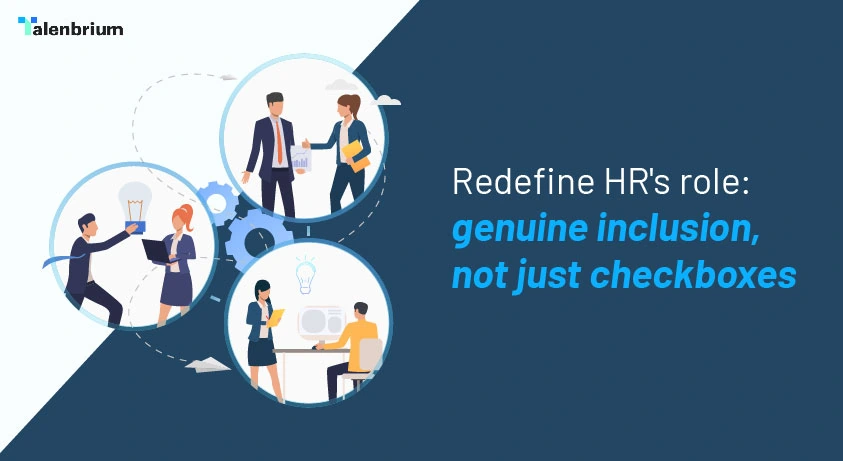Contact Us

Decoding the meaning of ‘check-box DEI’, put simply, characterizes surface-level efforts that fail to bring about real change.
Progressing from checkbox compliance in Diversity, Equality, and Inclusion (DE&I) initiatives is crucial for organizations to develop and encourage a genuine culture of inclusion and this will take a holistic and intentional approach by the Human Resource Department (HRD) as well as the entire management. Decoding the meaning of ‘check-box DEI’, put simply, characterizes surface-level efforts that fail to bring about real change. Examples range from poorly conceived holiday celebrations to controversial corporate merchandising, and the list could extend over time. Genuine advancement in Diversity, Equity, and Inclusion (DE&I) demands ongoing dedication and a pledge to continual enhancement. Companies must be prepared to allocate time, resources, and expertise to dismantle discriminatory systems, fostering an environment that not only appreciates diversity, but actively promotes inclusion.
Recent studies have indicated that a sizable percentage of employees are influenced by the culture within a company or organization, and this has a significant impact on decision to remain with current employer. A majority of employees, when asked about reasons for detaching with an employer, cited lack of perceived value on the part of organization or managers, while a number expresses lack of a sense of belonging as an obvious cause.
A primary measure to foster employee loyalty, drive performance, and instill importance is to create an environment to ensure an employee is respected and supported. This not only serves to attract new talent, but aids in retention, and building brand image. This measure and outcome is more pertinent when dealing with younger employees or workforce, as Gen Z candidates have indicated in surveys that a company’s commitment to diversity and inclusion is relatively important when they select an employer. Also, a sizable number of millennials expressed in recent surveys regarding their willingness to leave an employer if DEI initiatives are not offered.
Another aspect that has been coming to the fore is merely having or expressing intention to invest in DEI initiatives and following a superficial ‘check-box’ DEI training process carries some pertinent risks. While, the potential cost of attrition is substantial, encompassing recruitment, training, and the loss of productivity during the onboarding of a new employee, often estimated at three to four times a position's salary, it is also essential for companies to recognize that DEI is more than a mere ‘nice to have’ addition and engaging in superficial ‘check-box’ approach does not suffice. Other risks include those arising from not initiating DEI efforts, and the dangers associated with investing in inadequate DEI practices.
Companies lacking diversity miss out on top talent, as more than one-third of job seekers are reluctant to apply to organizations lacking diversity. Building a diverse and equitable organization requires intentional DEI efforts driven from the top down. Success in DEI programs hinges on equal support from both senior leadership and employees throughout the company.
HR should ensure genuine leadership commitment to DE&I initiatives as this is essential and needs to be communicated across the organization. Besides, active participation and championing of such initiatives by leaders sets the example for the rest. Also, education and training on unconscious bias, cultural competence, and inclusive leadership is essential, not just for the HR, but also for the employees, and implementing mandatory training to ensure that everyone has a foundational understanding regarding the importance of inclusion across an organization, is just as important.
In addition, establishing meaningful metrics to ascertain the effectiveness of DE&I initiatives, regularly assessing and analyzing diversity data, employee surveys, and other relevant metrics to identify areas of improvement are crucial exercises to ensure successful implementation and practice. Reviewing and updating HR policies to ensure these are inclusive and support a diverse workforce, implementing flexible work arrangements and inclusive practices that accommodate various needs and lifestyles and diverse recruitment and retention are also key areas to examine regularly. Collaborating with a workforce solutions partner dedicated to Diversity, Equity, and Inclusion (DEI) can assist companies in implementing the necessary assessments and initiatives to make meaningful progress in their organization.
Implementing diverse and inclusive recruitment strategies serves to attract a broad or diverse range of candidates, and developing and deploying an inclusive onboarding process and providing mentorship and sponsorship programs will support retention and encourage advancement of underrepresented employees or candidates. Establishing and supporting Employee Resource Groups (ERGs) that provide a platform for employees to connect, share experiences, and contribute to the organization's DE&I goals is important and has shown that members or employees who feel well served, enjoy greater feelings of inclusion. Encouraging ERGs to collaborate with leadership and HR to drive positive change also has positive outcomes over time.
HRs also need to create open channels for employees to voice concerns, share feedback, and suggest improvements related to DE&I, and regularly communicate updates on DE&I initiatives and progress to foster transparency. Providing training on cultural competence and sensitivity to enhance understanding among employees with different backgrounds and experiences is also a key part of the initiative. So is inclusive language and communication, as this entails the use of inclusive language in all communications to avoid unintentional bias and promotes inclusivity and diversity. Recognition and rewards for inclusive behaviors and contributions fosters an inclusive culture and drives continuous improvement.
However, while skepticism may exist regarding the legitimacy of Diversity, Equity, and Inclusion (DE&I) initiatives in certain corporations, it is crucial to acknowledge the strides made in advancing workplace diversity and inclusion. Nevertheless, it is imperative to stay vigilant and ensure that DE&I efforts transcend superficial checkbox exercises. To effect enduring change, organizations must adopt a comprehensive approach that extends beyond mere representation, actively tackling systemic barriers that contribute to inequality. Through promoting accountability, authenticity, and an enduring commitment to continual enhancement, corporations can genuinely drive progress and cultivate workplaces that not only embrace diversity, but empower all employees to flourish.
Your email address will not be published. Required fields are marked *